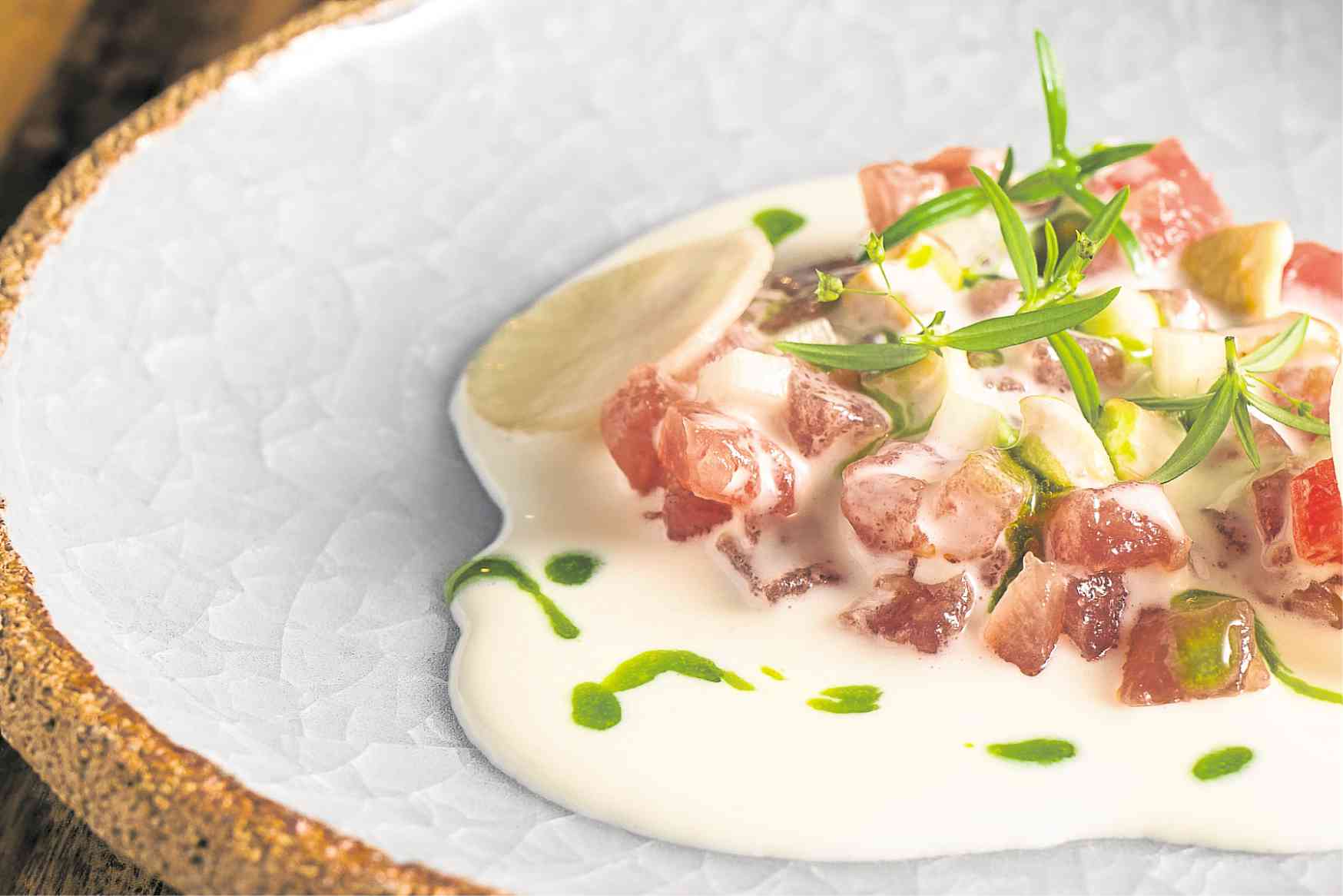
When Vask Gallery reopened as Gallery by Chele early this year, it was announced that chef Chele Gonzalez would also be opening a smaller, more experimental, venue, aptly named Studio Lab, or, as it is sometimes stylized, Stvdio Lab.
The driving idea behind it—it’s a more private, intimate setting with greater interaction with the chef—is L’Atelier de Joël Robuchon as opposed to La Table de Joël Robuchon. I don’t think that anyone as much of a perfectionist as Gonzalez, the chef behind both restaurants, would let people see anything so raw as a work in progre ss.
But with the scribbles on the walls, the books from which Gonzalez draws inspiration lining the shelves, and a turntable where they “put on a record and conceptualize,” it feels like you’ve entered a creative space.
As for the dining experience, the new Gallery by Chele is already pretty casual as it is. So, the main difference between eating at Gallery and at Studio Lab is that, in the latter, you’re much closer to the kitchen and can see the food being prepared, and you can chat with Gonzalez about the dishes being prepared.
And there’s no annoying pressure of the chefs staring at you while you bite into your food, or them peering at your plates to check if you’ve any leftovers. They’re much too professional for that.
Only at the end of the meal does Gonzalez ask: “Did you like the food?” And the answer would be heartfelt, in the affirmative.
In the drive to ground his Spanish haute cuisine training in local ingredients, practices and dishes, Gonzalez has taken several tacks, some of which are more successful than others— here I have to stress the caveat—at this point in time.
One of them, which seems to have gone on the back burner, is foraging for interesting and neglected ingredients, an approach taken by D.O.M. in Brazil, which finds forgotten or unknown rainforest ingredients and works with them. To a lesser extent, Noma does this well with Scandinavian ingredients.
Last year, Gonzalez sourced from the Aetas near Subic a tart leaf that resembled, in taste and texture, a thin slice of a Granny Smith apple. He called it “more precious than caviar,” which may have been overstating the case a bit, but we get the point.
The tart leaf appeared in two dinners I had there. While it felt like a solution in search of a problem, I thought that Gonzalez was on to something. This is where he—who doesn’t suffer the bias of growing up in the Philippines—enjoys an edge. Instead of dismissing unlikely ingredients as unimportant, he’ll say, “that’s interesting” and work with it.
A second way Filipino flavors come into the tasting menu is through miniaturized versions of vernacular dishes. Among the “bites” preceding the actual tasting menu were tiny versions of Ilocos empanada (I mean really tiny, barely bigger than a teaspoon), with piped dots of pinakurat emulsion on top.
One of the main dishes toward the end of the menu played on beef with broccoli that served up beef tendon in thickened sauce, with the very tips of the florets grated over it to give it a slight bitterness, and the barely cooked stem adding crunch. It was an excellent dish in itself, but the table conversation immediately compared it to Manila’s go-to place for tendon, Mien San in San Juan.
An in-house version of piaya were very, very tiny, like a child’s waistcoat buttons. For the mostly Filipino cast of characters dining that night, these dishes were an exercise in defamiliarization: doing a second take on familiar dishes and flavors.
But where Gonzalez succeeds best, and what I feel is his most important work, is simply creating new dishes.
Using Filipino ingredients is a bonus, but it’s not something I obsess about (though judges of Asia’s 50 Best, with their fetishism of the local, might feel differently).
These, as Brillat-Savarin put it, confer more happiness on humanity than the discovery of a new star, to which I might add, are as rare as the discovery, or the creation, of new stars.
In this category fall the best dishes of the evening: tuna tartare with cashew milk, ulang with Béarnaise sauce on a bed of upo seeds, an intriguing terre-et-mer combination with tiny piece of abalone and piece of pork crackling. These work very well. Even the ones that don’t quite work manage to be interesting. For me, the kare-kare-inspired banana heart with cashew nut sauce felt too close to a deconstruction.
Gonzalez describes the Studio Lab as an excuse to go crazy. My own feeling is that he should not just go loco, but should go stark raving mad.
I’m not privy to what the dynamic is between Gonzalez and his collaborator and new head Filipino chef, Carlos Villaflor. They were both plating and cooking at the dinner, with equal precision and attention to detail.
But I feel that the cooking at the multivenue complex formerly known as Vask has changed since it reopened. So, it would be remiss not to give credit to Villaflor, who receives equal billing with Gonzalez during collaboration dinners.
Also new to Studio Lab are consultancies (a completely legitimate way to monetize their creativity), and plans to collaborate with universities, agricultural institutions and the like. This is something very much needed.
I think it’s obvious that I liked Studio Lab very much. There are many directions the team can take this, but crazy is a good way to go. –CONTRIBUTED

